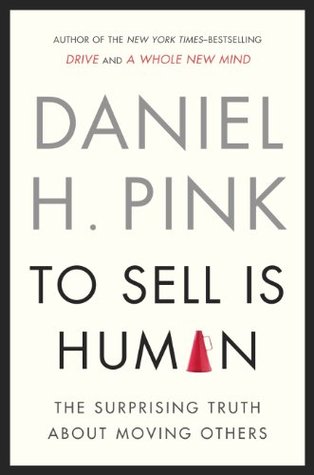More on this book
Community
Kindle Notes & Highlights
Read between
January 12 - February 3, 2020
40 percent of their time at work engaged in non-sales selling—persuading, influencing, and convincing others in ways that don’t involve anyone making a purchase.
crucial to their professional success—even
At the same time, large operations discovered that segmenting job functions didn’t work very well during volatile business conditions—and because of that, they began demanding elastic skills that stretched across boundaries and included a sales component.
in ways we’ve scarcely realized, most of us ended up in sales.
“reluctant capitalist.”
moving product and moving others.
he says his job is to influence employees—so they do their jobs with zeal and with skill. “I want everyone to be happy.
not the only point.
One is a nonfiction account of the September 11 attacks, so they’re better attuned to what happens when governments can’t make sense of information; the other is a British drama instructor’s guide to improvisational acting, so they understand the importance of nimble minds and limber skills.*
flat
fewer people who are doing more, and more varied, things.
A world of flat organizations and tumultuous business conditions—and that’s our world—punishes fixed skills and prizes elastic ones.
250 people
the new ABCs of moving others: A—Attunement B—Buoyancy C—Clarity
Since the mid-1980s, social psychologists have used this technique—call it the E Test—to measure what they dub “perspective-taking.”
how do we make sense of what’s going on? Do we examine it from only our own point of view? Or do we have “the capability to step outside [our] own experience and imagine the emotions, perceptions, and motivations of another?”1
Attunement is the ability to bring one’s actions and outlook into harmony with other people and with the context you’re in.
1. Increase your power by reducing it.
“High-power participants were almost three times as likely as low-power participants to draw a self-oriented ‘E.’”2 In other words, those who’d received even a small injection of power became less likely (and perhaps less able) to attune themselves to someone else’s point of view.
“power leads individuals to anchor too heavily on their own vantage point, insufficiently adjusting to others’ perspective.”3
Power can move you off the proper position on the dial and scramble the signals you receive, distorting clear messages and obscuring more subtle ones.
the ability to move people now depends on power’s inverse: understanding another person’s perspective, getting inside his head, and seeing the world through his eyes.
Assume that you’re not the one with power.
those with lower status are keener perspective-takers.
When you have fewer resources, Keltner explained in an interview, “you’re going to be more attuned to the context around you.”4
using an apparent weakness as an actual strength. Start your encounters with the assumption that you’re...
This highlight has been truncated due to consecutive passage length restrictions.
Perspective-taking is a cognitive capacity; it’s mostly about thinking.
Empathy is an emotional response; it’s mostly about feeling.
ultimately it’s “more beneficial to get inside their heads than to have them inside one’s own heart.”
“having eyes” or “reading a table.”
“social cartography.”
It’s the capacity to size up a situation and, in one’s mind, draw a map of how people are related.
scientists view mimicry differently. To them, this tendency is deeply human, a natural act that serves as a social glue and a sign of trust.
“chameleon effect.”
Synching our mannerisms and vocal patterns to someone else so that we both understand and can be understood is fundamental to attunement.
The key is to be strategic and human—to be strategic by being human.
“The most common thread in the people who are really good at this is humility,”
“They take the attitude of ‘I’m sitting in the small chair so you can sit in the big chair.’”
That’s perspective-taking through reducing power, the first ...
This highlight has been truncated due to consecutive passage length restrictions.
The notion that extraverts are the finest salespeople is so obvious that we’ve overlooked one teensy flaw. There’s almost no evidence that it’s actually true.
extraversion has “no statistically significant relationship . . . with sales performance” and that “extraversion is not related to sales volume.”
the ambiverts.
people who are neither overly extraverted nor wildly introverted.30
the “most destructive” behavior of salespeople wasn’t being ill-informed. It was an excess of assertiveness and zeal that led to contacting customers too frequently.
talk too much and listen too little,
Jim Collins,
He says his favorite opening question is: Where are you from?
“ability to chameleon”—to adjust what they do and how they do it to others in their midst.
The three key steps are Watch, Wait, and Wane:
Watch. Observe what the other person is doing.


